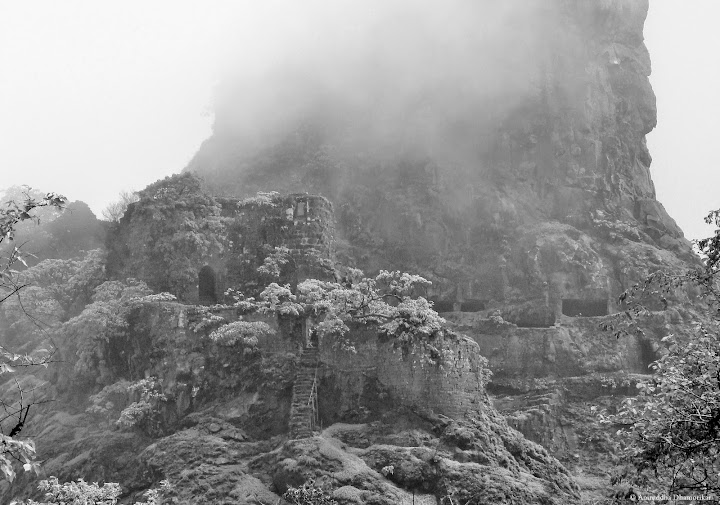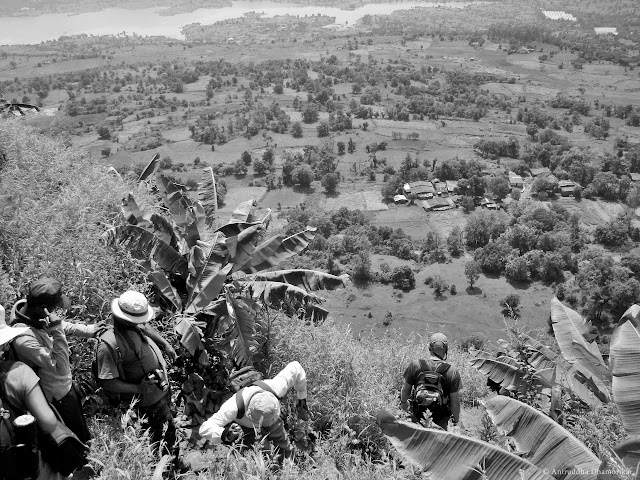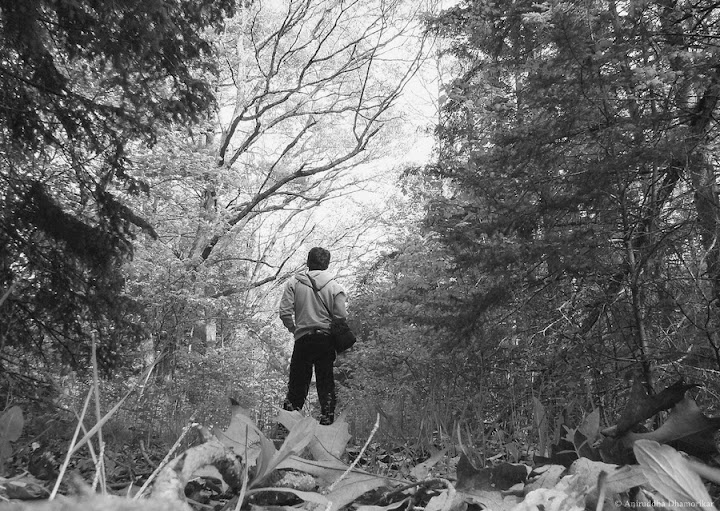Putting the wild back in life
“You have to get lost
before you can be found.”
― Jeff
Rasley, Bringing Progress to Paradise: What I Got from Giving to a Mountain
Village in Nepal
The sun setting over your shoulder in a forest wilderness as
a dark rainstorm approaches from the east is not the time for you to be out
trekking on the cliff of the Western Ghats. But here you are: with your
trekking friends and family, battling to conquer the fort, struggling with your
inner fears; and here you want to be: beating down the stinging rain, and ever
marching on. For you have shed blood and sweat on your way up. For you have
prepared to complete this trek, and, more importantly, you have left behind the
rat-race which you think life is all about: now, you are not chasing targets,
you are chasing your ambition. You are encouraging your friends to tarry with
you. You are their emotional leader, and although you know that the light fades
and you’re being stalked by a rainstorm, you sit back on a rock to enjoy the
view with your ambitious fort in front of you, a part of it gleaming in the
evening sunlight, another dreary under the growing shadows.
| A storm is coming Manikgad Fort |
The days spent in office staring at a radiating computer
screen, in meetings in somber conference halls, in A/Cs mimicking the cool air
of nature, in commuting to work, you have left this all behind. Such was the
life you knew before you boarded that bus, or before you booked that ticket to
be on this trek. You thought twice, maybe thrice, and consulted those who’ve
been on a trek and those who’ve never. And instead of finding answers you were
left confused and dissident: a part of you wants you to remain in the comforts
of your home; a part of you wants to push your limits.
Then, you stopped
thinking about it. Days went by shuttling between the office and home. In the
monotony of your life you became so engrossed that the day you never thought
would happen, happened. You had accepted the challenge.
| Rolling hills overlooking the vast plains of Sahyadri Sindola Fort |
What kindled the light in your mind – the lost flame of
adventure and a life that you thought only existed in books? What made you put
the wild back in your life? I’ve wondered about this far too long, and I’ve
come to the conclusion that it is spontaneous. What we’re suffering from today
is an urban curse – a spell cast upon by unintentional peer pressure – to
perform, to deliver, to submit. Seldom, if ever, do we have visions of
untouched forests, for they are mired by stress and workload. And seldom, if
ever, do we inhale the fresh breath of air, for we deem the air blasted by A/Cs
to be freshest. But only when you experience the untouched forests and breathe
the freshest forest air, are you broken from the urban spell.
| Play of sun and rain in the hills of Konkan Manikgad Fort |
Yet as an addiction the urban curse comes back to us,
taunting us at the back of our mind, wielding us and shaping our conscience. In
an age where time is calculated by the quantity of hours you put into your
work, and not in the quality of work you completed in record time, we equate
this psychology in all forms of activities we do in our lifetime. Invariably,
the more amount of work you put in, the more you’re attracted to your bed. And
that’s how majority of us spend much of our time on weekends: lazing in front
of the TV or the computer, gazing blindly into the neon light.
 |
| A fort carved in the giant monolith Karnala Fort |
According to an American time-use survey
undertaken in 2012, an average working person spends 2.8 hours per day watching
TV as a leisure activity, and, to quote the report, “…individuals age 75 and
over averaged 1.0 hour of reading per weekend day and 20 minutes playing games
or using a computer for leisure. Conversely, individuals ages 15 to 19 read for
an average of 7 minutes per weekend day while spending 1.0 hour playing games
or using a computer for leisure.” The survey also reveals (see Table 2 of the report)
that on an average, about 9.41 hours are spent sleeping on weekends, and only
2.11 hours spent “participating in sports, exercise, and recreation”.
And here’s where our problems lie – hidden conspicuously in
numbers. And just maybe, if the right numbers come together, we can change
that, we can ignite a sparkle in our life.
| Overlooking the mammoth Jivdhan fort Naneghat |
So I asked myself: what would it take me to put the wild
back in my life? – Ideally, I’d want to lessen the number of working hours and
– if my workplace is far – travelling hours. Then, I’d want to find like-minded
folks who’d want to share my adrenalin rush. Then, I’d want to see if the trip
I was going to make was economic. And lastly, if I can physically make it.
That’s all the ingredients I require, I thought. But not quite. Behind all of
these calculable, measurable ingredients, I’d also want freewill, knowledge, and willingness to do it – and none of this
can be changed for you but by you.
 |
| Climbing down the steep ghats Tung Fort |
A number of research and a number of articles have been
published looking at increasing productivity at work by planting garden and by
working in natural light. These homemade remedies, research shows, work by
acting on our physiology and psychology: improved mood, enhanced morale, lower
fatigue, and reduced eyestrain are some of the direct benefits of working under
natural lights – a tool used by green buildings in their sustainable designs (Edwards and Torcellini, 2002).
The authors also quote Robbins (1986), “one
of the important psychological aspects from daylighting is meeting a need for
contact with the outside living environment”. Another report sums the
importance of green spaces pretty well: “interaction with gardens and natural
spaces offers a variety of mental, physical and social benefits for humans,
ranging from stress reduction, quicker healing, and mitigation of Attention
Deficit Disorder in children to decreasing crime and air pollution” (Barton and
Pineo, 2009).
| Chasing light through the basalt giants of Sahyadri Naneghat |
Over the years, we have been mentally programmed to see the
“wild” for the unknown and uncharted; to fear the raw heathenness hidden in it.
What society has taught us invariably is that manicure and pedicure, and a
neatly shaven face, is the notion of life. Nobody forged it, nor did anybody
accept it – everybody just did it. I’m not stopping you from doing it (nor
would I), but in our personal activities we forgot a part of life which was
once larger for us than any – to belong to the wild, to fall, to plant a tree
and reap its gains, to walk barefoot and to feel the sun and the rain.
| Embracing the monsoon winds Sindola Fort |
And you fought
back all your inner fears and went on that first climb of yours. You imagined
failure written all over it when you started it: it was too sweaty, too many
mosquitoes swarmed you, you slipped twice, and you hated it. But you stood up
to these challenges as you would fight the deadlines from your work-desk. You
replied with an undefeatable assertion that you’re a survivor to an e-mail cast
at you by the wilderness. And in your physical exertion you experienced a
whisper that calmed your mind of your daily grind: you had made it to the top
of the fort. You congratulate yourself and your partners.
| The shepherd of the Ghats Sindola Fort |
This is anthesis, a moment when a bud unfurls its petals to
become a functional flower. This is your anthesis: the moment when you don’t
feel, you know, that you’re strong mentally and physically, that the universe
is as much a part of you as you are of the universe. That the dirt you’re
standing on is not alien to you, or you to it: we’re one and the same thing.
| Photographing the low-altitude clouds Korigad Fort |
Let not those scratches and bites bother you, for they’re
your souvenir which will fade away and return you back to your former beauty;
but forget not the medal of honour you deserve, for no material-world will
deliver you the pleasures of life that nature does.
 |
| Gazing in the living giants of our planet Carolinian Forests |
And forget not to tell the world how beautiful it is to cast
your shell of cement, to welcome the grip of sighing winds and whining trees –
tell them about how you put the wild back in life, and discovered to live.
--
A number of treks can be organized independently by a group
to the forts of Sahyadri and Konkan. Professional help can be sought online or
locally. Some of the resources for trekking can be found here:
3. Trekshitiz
Come monsoon, a number of organizations conduct a number of
short and long treks across India. I’ve made a short list of those that I know
focus around Western Ghats and Konkan below.
Note: This list is
non-exhaustive and trip details are provided by the respective organizers.
Please contact them for further information.
Mumbai/Pune:
2. BNHS
4. Nyass
Trust
5. Mid Earth
7. Wild
Quest
8. Pugmarks
10. Gypsies Outdoors
Another note: Leave
behind nothing, take back only memories. Sahyadrica will not be held
accountable for suggesting the treks or the organizations. The responsibility
rests with you or the trip organizer, and not with Sahyadrica. You will have to be mentally and physically
prepared to be on the trek. The names of the organizations have been included
without any benefits received, nor given. There are several other local
organizations which conduct treks and trails across India, you can look them up
on Google or via friends and relatives.
Encouraging, indeed!
ReplyDelete